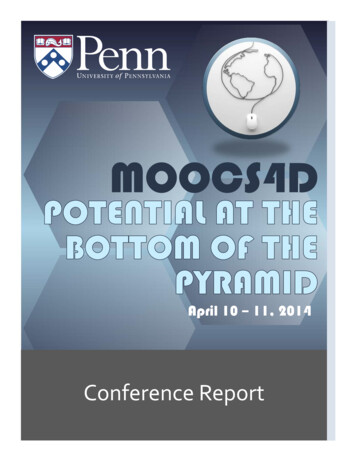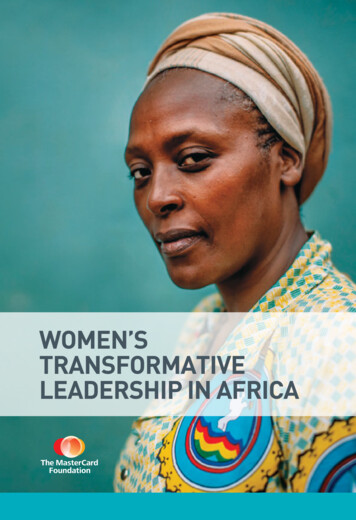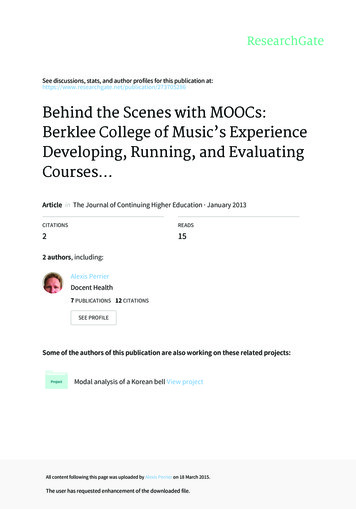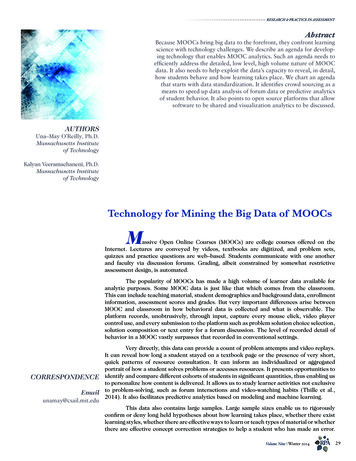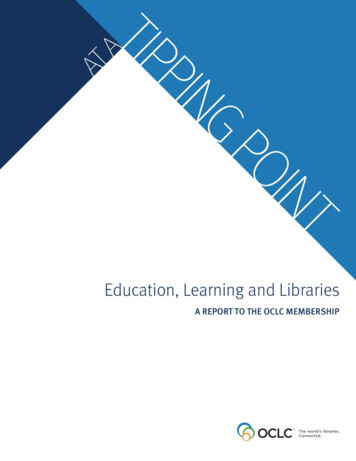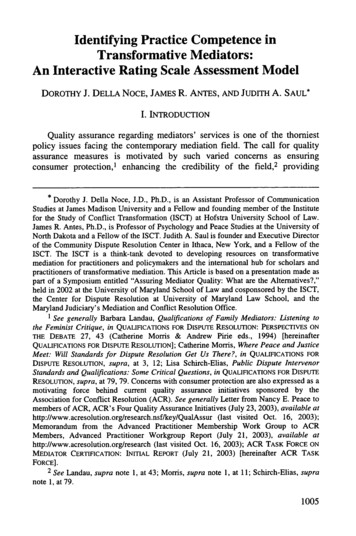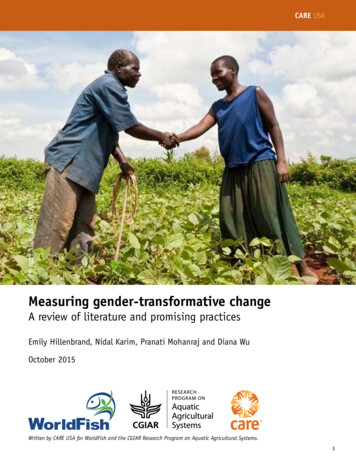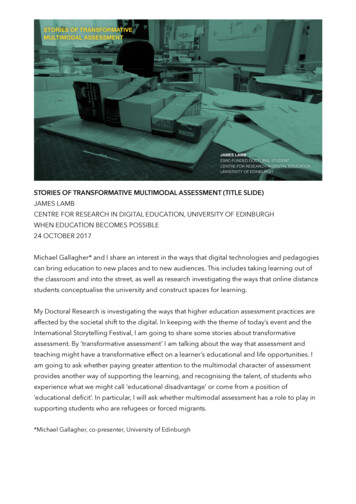
Transcription
MOOCS REVISITED: STILL TRANSFORMATIVE OR PASSINGFAD?Joseph Rene CorbeilThe University of Texas Rio Grande Valley, USARene.corbeil@UTRGV.eduBadrul H. KhanMcWeadon Education, USAbadrulkhan2003@yahoo.comMaria Elena CorbeilThe University of Texas Rio Grande Valley, USAReceived: 27 November 2018Accepted: 8 January 2019Published: 30 January 2019ABSTRACTAlthough Massive Open Online Courses have been in the media limelight for a relatively shorttime, their roots date back to the Open Access movement of the early 1990s as access to the WorldWide Web was increasing and online publishing was coming of age. Once heralded the greatdisruptors of higher education, the hype surrounding MOOCs has fluctuated through multipleupsurges and slumps over the past 5 years (Corbeil & Corbeil, 2015). Are MOOCs the greatdisruptors of higher education? Are they a passing fad? What is the status of MOOCs today? Wherewill they be 5-10 years from now? This paper will attempt to answer these questions by providinga brief history of the MOOC phenomenon from its early beginnings, through its quick ascension,into a period of experimentation and soul-searching, concluding with a look at today's MOOCsand where they are heading in the next five to ten years.Keywords: Massive Open Online Courses, online education, micro-masters and bachelors, nanodegreesIntroduction: The Rise of the MOOCsThe first course on record to use the ‘MOOC’ designation was Steven Downs and GeorgeSiemens’s Connectivism and Connective Knowledge/2008 (CCK8) (Marques & McGuire, 2013).Not knowing what to expect, the course was open to anyone interested in taking it. Approximately2,200 people signed up. Though miniscule by typical MOOC enrollment levels, it was nearly 100times more participants than Downs or Siemens expected (Parr, 2013).After CCK8, MOOCs developed slowly over the next two years. Then, in 2012, aComputer Science Professor at Stanford University, Sebastian Thrun, announced the release of a
new MOOC, Introduction to Artificial Intelligence. Within a few weeks, the course had over160,000 registered students (Aulet, 2013). Motivated by the immense interest in his AI course,Thrun cofounded Udacity in February 2012 with David Stevens and Mike Sokolsky. Its missionwas simple: “to bring accessible, affordable, engaging, and highly effective higher education tothe world” (Udacity, n.d. para 1). The AI course became the "template" for future MOOCs andwas credited with inciting the "MOOC revolution" (Aulet, 2013, Production Value, para. 3).Two months after Udacity’s founding, Andrew Ng and Daphne Koller founded Coursera(Coursera. n.d.), followed quickly by edX, founded by Harvard and MIT (edX, n.d). Within thespan of one year, the big three MOOC providers, Udacity, Coursera, and edX, were established,offering dozens of free online courses to nearly 5 million users worldwide. Despite having a 40year head start in distance learning, UK’s Open University was a late starter in the MOOC arena.It finally jumped in with Futurelearn, launching its first course in September 2013. Within a year,it had over 1 million course registrations (Futurelearn, n.d.).The period of rapid expansion climaxed in 2012 when the New York Times proclaimed2012 “The year of the MOOC” (Pappano, 2012). By year’s end, MOOCs had become a worldwidephenomenon. Yuan and Powell (2015) present a timeline of the MOOC evolutionary process overa 15-year period. See Figure 1.Figure 1. Yuan and Powell’s (2015) timeline of the evolutionary process of MOOCdevelopment.
The Age of ExperimentationWhile 2012 could be characterized as the year of explosive growth for MOOC startups, 2013 couldbest be described as the beginning of the age of experimentation. In that year, Udacity partneredwith San Jose State University to offer a series of online courses, at a cost of 150 each, foracademic credit (Ha, 2014). Seven additional colleges also announced plans to award collegecredit to students who could demonstrate knowledge acquired from completed MOOCs (Daly,2013). Despite great promise, pass rates were dismal, and few students actually received academiccredit for their MOOC related coursework (Weiner, 2013).In 2014, edX announced that it would begin to offer courses to high school students(Morrison, 2014). Soon afterward, the State of Florida enacted a bill allowing high school studentsto take MOOCs for credit in computer science, biology and mathematics (Morrison, 2014).Envisioned as a cost-saving measure for schools, the new law required certified Florida teachersto manage the courses for the MOOC providers (Horn, 2014). Also, in 2014, Arizona StateUniversity partnered with edX through its Global Freshman Academy to offer a full year ofacademic credit to first-year students at a sizeable discount. The courses would be listed on theuniversity’s official transcripts. Yet, from over 34,000 participants, less than 1% were eligible toearn college credit for their work (Straumsheim, 2015).While MOOCs-for-credit were not catching on with students, faculty in higher educationbegan experimenting with MOOCs, not as replacements for courses, but as supplements to coursesand substitutions for textbooks. One example of the use of a MOOC as courseware was AmyHagenrater-Gooding’s undergraduate Studies in Poetry course at the University of MarylandEastern Shore (Hagenrater-Gooding, 2015). In that course, Hagenrater-Gooding wrapped a 16week course around the 10-week MOOC. This integration of a MOOC with a traditional coursecaught on with faculty around the world and is continuing to this very day.After experiencing limited success in public and higher education, MOOC providerspivoted from the education sector to the business sector. In 2014, AT&T and Udacity teamed upto offer nano-degrees to prepare new hires for entry-level jobs within the company (LeBar, 2015).Google also worked with Udacity to create MOOCs in game design and Android to trainprogrammers to work on Google platforms (Porter, 2014). Later that year, Coursera announcedthat it too would work with companies like MasterCard and Shell to provide specialized coursesfor their employees (Parr, 2014).In October 2015, MIT launched the MITx MicroMasters credential on edX. The programenabled online learners to complete six graduate-level courses for a total cost of 1,200. Learnerswho successfully completed the MicroMasters credential become eligible to complete a master’sdegree in Supply Chain Management by taking one additional semester on the MIT campus. In thefollowing year, edX expanded the MicroMasters to 18 new programs across 13 universities.According to Sanjay Sarma (as cited in Office of Digital Learning, 2016), vice president for openlearning at MIT, “MicroMasters gives learners the opportunity to demonstrate their abilitiesthrough a series of online courses, earn a valuable credential and, if they excel, complete theirmaster’s with an additional semester’s residence” (para. 3).
On January 13, 2016, Sebastian Thrun, the founder of Udacity, tweeted the announcementof a new program dubbed the Nanodegree Plus with a guarantee of a job within six months or yourmoney back (Sebastian Thrun, 2016). At launch, the program included four nanodegrees: AndroidDeveloper, iOS Developer, Machine Learning Engineer, and Senior Web Developer (Shah,2016b).While some MOOC initiatives were beginning to show promise, in 2016, MOOCs suffereda significant setback as advocates for the deaf filed lawsuits against Harvard and MIT for violatingantidiscrimination laws by not providing closed captioning to their online materials (Lewin, 2015).In 2016, University of California, Berkeley was notified by the United States Department of Justicethat it’s MOOC content also violated Title II of the Americans with Disabilities Act (ADA) fornot addressing accessibility issues in their media content. As a consequence, on March 15, 2017,UC Berkeley took all of their free MOOC content, including more than 20,000 audio and videofiles, offline for non-UC Berkley students. According to a spokesperson for the university,captioning for the videos would exceed one million dollars (Loftus, 2018). The ramifications ofthese lawsuits were enormous as they could potentially impact hundreds or thousands of coursesthat would need to be updated to satisfy the requirements of the law.Though by the end of 2014, the hype surrounding MOOCs had appreciably subsided,MOOC providers continued to experiment and innovate. Yet, the setbacks experienced during theperiod of experimentation resulted in significantly lowered expectations. According to Kolowich(2015),The conventional wisdom [regarding MOOCs was] that free online courses offer apromising recruiting tool and an interesting (but not essential) research tool for collegesthat can afford the upkeep, while also nudging more-conservative institutions to finallystart integrating online coursework into the curriculum (para. 8).In a January 2015 interview, Daphne Koller, one of Coursera’s cofounders, disagreed. Shenoted, “ there was a lot of disillusionment because people saw that over the course of 12 monthswe hadn’t put any universities out of business .” (Knowledge@Wharton, 2015). According toKoller, the negative hype surrounding MOOCs was unmerited.The MOOC Hype CycleIn the previous section, Koller’s observation regarding the negative hype surroundingMOOCs, makes a reference to Gartner’s Hype Cycle (Gartner, n.d.). According to Gartner (n.d.),all technologies go through a "hype" cycle that is punctuated by five distinct periods. For thisarticle, Figure 2 below, adapted from the Gartner Hype Cycle of key MOOC events/ developments(Bozkurt, Özdamar Keskin, & de Waard, 2016), was updated to reflect the rise, fall, andreemergence of MOOCs over a ten-year period along the Gartner Hype Cycle. The points on thegraph are not intended to be all-inclusive, but to highlight key transition points in the timeline.
Figure 2. MOOC milestones visualized through the Gartner Hype Cycle. Adapted fromGartner Hype Cycle of key MOOC events/developments (Bozkurt, Özdamar Keskin, & deWaard, 2016)The trigger for the MOOC phenomenon can be traced to Downs and Siemens’sConnectivism and Connective Knowledge/2008 (CCK8) course in 2008. It was the first course touse the “MOOC” moniker. Followed by the runaway success of Thrun’s AI course in 2011,MOOCs expanded quickly through 2012, resulting in the formation of Udacity, Coursera, andedX, the big three MOOC providers in the United States. The hype surrounding MOOCs reachedits apex in November 2012 when the New York Times proclaimed 2012 ‘The Year of the MOOC’.Over the next two years, MOOCs entered a period of experimentation resulting in numerousmistakes and false starts. Media accounts of MOOC disasters, dismal completion rates, andrampant cheating began to take their toll, and by the end of 2014, the once promising disruptor ofhigher education had begun to lose its sheen, leading to a period of disillusionment (Corbeil &Corbeil, 2015).Yet, through dogged perseverance and a shift in focus from higher education to corporatetraining, MOOCs began to evolve. In 2015, MOOC providers tested a variety of business modelsto make them profitable. Freemium models offering free content with up-sell options forcertificates and badges resulted in increased completion rates for paying students (Kronk, 2018).Partnerships with government and industry began to pay off. In 2016, MOOCs reemerged into thelimelight but this time, the MOOC providers were more targeted. They had identified their targetaudiences and refined their business models (Kronk, 2018). Although they will undoubtedly
continue to mature over the coming years, today, in 2018, MOOCs appear to be on a trajectorytoward productivity and relevance (Corbeil & Corbeil, 2015).MOOCs TodayToday, the big three offer over 7,000 courses through more than 700 university partners,and have enrolled over 23 million people worldwide (Gallagher, 2017). No longer considered athreat to higher education, MOOCs are finding their niche in corporate training and personalizedlearning. According to Gallagher (2017), author of The Future of University Credentials: NewDevelopments at the Intersection of Higher Education and Hiring:Today’s more mature marketplace of MOOC-based learning has pivoted away from freegeneral interest courses, and is instead focused on fee-based certificates and professionalprograms This program-level rather than course-centric approach is spawning entirelynew types of postsecondary credentials—and further, MOOC-based rebecominginterwoveninto traditional higher education programs (para. 2).Recognizing that the MOOCs-for credit initiatives were not catching on with universitiesas MOOC providers had hoped, Steven Klinsky, founder of the Modern States Education Alliance,devised a way around MOOC accreditation issues (Modern States Education Alliance, n.d.).Instead of trying to convince universities to accept MOOC courses for credit, he developed theFreshman Year for Free program to prepare students to sit for Advanced Placement (AP) andCollege Level Examination Program (CLEP) tests (Modern States Education Alliance, n.d.). Theexams, accepted by more than 2,900 colleges and universities, are available on demand, across1,800 testing centers across the United States (Ukueberuwa, 2018).Today, the Freshman Year for Free program, working in partnership with edX and tenuniversities, offers 32 tuition-free CLEP courses—one for every subject in the College Board testlibrary (Ukueberuwa, 2018). According to Ukueberuwa (2018), the courses allow students toprepare for the credit-granting exams through online courses that include practice exercises andtests with questions closely matching those on the actual tests.Building upon on the successes of the Freshman Year for Free and MicroMaster’sprograms, in January 2018, edX announced the development of a new MicroBachelors degree,“designed to break the undergraduate credential into Lego-like components” (Young, 2018, para.1). While describing his vision for the MicroBachelors degree, edX CEO, Anant Agarwal (as citedin Young, 2018), predicted education in the next five to ten years would become more “modular,”“omnichannel,” and “lifelong” (para. 3). According to Dhawal Shah at Class Central, today, thereare over 500 MOOC based credentials, including 22 Nanodegrees by Udacity, 43 MicroMasters,35 Professional Certificates by edX, 257 Specializations by Coursera, and 22 programs byFutureLearn. Based on these developments, on January 20, 2018, Class Central published thefollowing list of the six biggest MOOC trends of 2017:
1. Fewer MOOC courses are available free of charge. Today’s MOOCs range in cost fromfree, or free to audit, to millions of dollars, with each pricing tier adding value over thepreceding tier.2. More MOOC content is behind paywalls. As MOOC providers searched for sustainablebusiness models, paywalls were initiated to differentiate the non-credential from credentialcourses.3. MOOCs find their audience. The audience of today’s MOOCs is characterized as the“lifelong career learner,” who is seeking professional and career advancement.4. MOOC providers are investing big in degree program and corporate trainingmarkets. Shifting away from individual courses, MOOC providers are developingcomplete undergraduate and graduate degrees and corporate training programs.5. MOOCs are becoming more flexible and convenient. Instead of offering cohort-basedcourses with specific start and end dates, MOOCs are enabling learners to start anytime.6. Campuses are beginning to accept MOOCs. Campuses are warming up to the idea ofallowing students to earn credit from MOOCs, even MOOCs from other universities.These trends reveal how MOOCs have evolved since their inception. According to Shah(2018), while MOOCs were not the end of traditional higher education as originally expected, they“may have changed how working professionals access continued learning and career-advancementopportunities” (para. 4). He added, consequently, “ . 2017 could just have been the year MOOCsbecame big business” (para. 5). As a result, now business people and educators are looking aheadto what the next iteration of MOOCs may bring.Summary and Future DirectionsHave MOOCs lived up to the hype? Are they still relevant? What will future MOOCs looklike? Based on recent trends, future MOOCs probably won’t be as massive. They also won’t be asopen, and many of them won’t resemble typical courses. MOOCs will begin to target a narrowerniche of learners, focusing on delivering highly specific workforce skills to corporate workers. Asmore MOOCs offer certifications and nanodegrees, fewer MOOCs will be free, making them lessopen to learners in developing countries. These MOOCs will become more individualized and selfpaced, with no formal start and end date, enabling learners to enroll at any time, and take as muchtime as they need to complete the courses. Interactions among learners in these courses will bevoluntary, resembling interactions found on social media sites and specialized message boards. Asa result, future MOOCs may need a new name to describe them, since they will lose many of theinitial characteristics that made them MOOCs (Corbeil & Corbeil, 2015).Looking to the future, the following trends seem to be emerging: The MOOC name will go away. In a 2017 opinion piece submitted to Inside HigherEd,Cathy Sandeen (2017) predicts the term “MOOC” will go away. “I am somewhat surprisedthe moniker has stuck around as long as it has, because what exists today is quite differentthan what we were discussing five years ago” (Sandeen, 2017, para. 3). According to ClassCentral CEO Dhawal Shah, the MOOC name has evolved from its original meaning intomore of a marketing term. Today’s MOOC providers are distancing themselves from theMOOC provider designation by differentiating their products and creating their own brands
onk,2018b). MOOCs will continue to unbundle higher education. Jim Hundrieser, associatemanaging principal for institutional strategies at the Association of Governing Boards,foresees the unbundling of higher education due to the introduction of nanodegrees andmicro-credentialing (Arnett, 2017). According Arnett (2017), Hundrieser compares theearning of a college degree to having to buy an entire album for just one or two goodsongs, suggesting that professional certificates and micro-credentials are becomingmore important to students and employers. If this is the case, Hundrieser suggests,MOOCs may still be a disrupting force in higher education (Arnett, 2017). AI-Powered MOOCs will personalize MOOC learning. Yu, Miao, Leung and White(2017) offer a perspective on how advances in Artificial Intelligence (AI) may enhancelearning in MOOCs. They envision using AI in future MOOCs to: (1) enable students topersonalize their learning by allowing them to adjust the sequencing of content to fit theirneeds; (2) provide personalized attention to learners by matching teaching assistants tomediation tasks; and (3) use virtual learning companions with human traits to interact withlearners one on one. According to Hill (2018), in January 2018, the Georgia Institute ofTechnology launched its first MOOC with an AI teaching assistant named “Jill Watson,”based on IBM's AI Watson platform. Ashok Goel, Georgia Tech professor and creator of JillWatson says he would like to see virtual learning companions universally available, “forevery class, at every school, at every level” (as cited in Hill, 2018, para. 17). MOOCs will serve as catalysts for the learner revolution. While no longer considered thedisruptive technology that would put universities out of business, MOOCs have made a hugeimpact on higher education and are credited with inspiring what Van Der Werf (2014)dubbed, “the learner revolution” (p. 1).As we contemplate where MOOCs appear to be headed over the next 5-10 years, will they becomethe great disruptors of higher education as once predicted or settle into specialized training forniche markets? Has the disruption already begun and can we predict its destination? We will haveto wait for the next chapter in the history of MOOC’s to be written to know the answer to thesequestions.ReferencesArnett, A. A. (2017, March 12). 4 trends poised to transform the future of higher education.Retrieved from /Aulet,B. (2013, May 17). A review of the Stanford AI class. Retrievedfrom nford-ai-class.htmlBozkurt, A., Özdamar Keskin, N., & de Waard, I. (2016). Research trends in massive open onlinecourse (MOOC) theses and dissertations: Surfing the tsunami wave. Open Praxis, 8(3),
203- 221.Corbeil, M. E. & Corbeil, J. R.(2015). Massive open online courses: Past, present and future. TheMOOC Case Book: Case Studies in MOOC Design, Development and Implementation. InJ.R. Corbeil, M.E. Corbeil & B. Khan (Ed.) New York: Linus Learning, 2015: 17-30.Coursera. (n.d.). Our mission. Retrieved January 26, 2015, from https://www.coursera.org/aboutDaly, J. (2013, September 16). Credit for MOOCs is one step in a long journey towardrelevance. EdTechFocusonHigherEducation. Retrievedfrom nceedX. (n.d.). About us. Retrieved from https://www.edx.org/about-usFuturelearn. (n.d.). About. Retrieved from https://www.futurelearn.com/aboutGallagher, S. (2017, August 16). How MOOCs are inspiring the future of higher education. VoicesinEducation.HarvardEducation tnerHypeCycle.(n.d.).Retrievedfrom logies/hype-cycle.jspHa, T. (2014, January 27). What's a MOOC -- and where are they going next? Retrieved -moocsHagenrater-Gooding, A. (2015). Wrapped up in words: Merging a MOOC with a traditional poetrycourse for increased success. In J.R. Corbeil, M.E. Corbeil, M.E, & B. Khan (Eds.), TheMOOC Case Book: Case Studies in MOOC Design, Development and Implementation (pp.327-336). Linus Books: N.Y.Hill, J. (2018, January 29). Artificial intelligence can make MOOCs smarter. Retrieved -make-moocs-smarterHorn, M. B. (2014, March 03). MOOCs for high school: Unlocking opportunities or substandardlearning. EducationNext 14(3). Retrieved from @Wharton. (2015, January 5). The hype is dead, but MOOCs are marching on [Audioblog post]. Retrieved from akingprogress-hype-diedKolowich, S. (2013, February 18). Professor leaves a MOOC in mid-course in dispute overteaching [Blogpost]. WiredCampus.Retrievedfrom eaves-a-mooc-in-mid-course-in-
dispute-over-teaching/42381Kronk, H. (2018a, February 07). In coverage of online courses, generalizations prevail. Retrievedfrom ourses-generalizations-prevailKronk, H. (2018b, February 14). What does 'MOOC' mean anymore? The latest from ClassCentral. Retrieved from eBar, M. (2015, January 19). Nano-degrees as a new model to integrate into highereducation. Forbes. Retrieved from gher-educationLewin, T. (2015, February 12). Harvard and M.I.T. are sued over lack of closed captions.Retrieved from ses.htmlLoftus, P. (2018, January 04). UC Berkeley revoking public access to educational media, citescaptioning costs. Retrieved from ng-captioning-costsMarques, J. & McGuire, R. (2013, June 7). What is a Massive Open Online Course anyway?MN R attempts a definition. Retrieved from n-online-course-anyway-attempting-definitionModern States Education Alliance. (n.d.). Whoweare.RetrievedfromMorrison, N. (2014, June 25). The future of MOOCs in the classroom. Forbes. Retrievedfrom 5/the-future-of-moocs-in-the11-18-classroomOffice of Digital Learning. (2016, September 20). Thirteen universities adopt MicroMasters andlaunch 18 new programs via edX. Retrieved from 0920Pappano, L. (2012, November 2). The year of the MOOC. The New York Times. Retrievedfrom apid-pace.html?pagewanted all& r 0Parr, C. (2013, October 17). MOOC creators criticise courses’ lack of creativity. Times HigherEducation. Retrieved from .fullarticleParr, C. (2014, September 11). The evolution of MOOCs. Times Higher Education. Retrievedfrom ion/the-evolution-ofmoocs/2015614.article
Porter, E. (2014, June 17). A smart way to skip college in pursuit of a job. The New York Times.Retrievedfrom ach-to-college.html? r 0SebastianThrun. (2016, January 13). "Dream come true? We now GUARANTEE a job for anyonewho completes a Nanodegree - or else tuition back. Hope other universities .com/SebastianThrun/status/687315602973691904?ref src twsrc%5Etfw&ref url , C. A. (2013). Integrating MOOCs into traditional higher education: The emerging‘MOOC 3.0’ Era. Change: The Magazine of Higher Learning, 45,6: 34–39.Sandeen, C. A. (2017, June 22). MOOCs moving on, moving up. Inside HigherEd. Retrieved 2/essay-looking-back-predictionsabout-moocsShah, D. (2016a, January 26). Udacity's nanodegree plus comes with a job guarantee. ClassCentral. Retrieved from degree-pluscomes-job-guaranteeShah, D. (2016b, September 5). MOOCs no longer massive, still attract millions. Retrieved nger-massive-still-attract-millionsShah, D. (2018, January 22). A product at every price: A review of MOOC stats and trends in2017. Retrieved from state-uUdacity. (n.d.). About us. Retrieved from https://www.udacity.com/usUkueberuwa, M. (2018, February 09). Return of the MOOCs. Retrieved from 0.htmlVan Der Werf, M. (2014, November 12). The ed tech revolution is about to become the learnerrevolution. Education Design Lab. Retrieved from earnerRevolution EduWiener, J. (2013, September 4). Inside the Coursera hype machine. The Nation. Retrieved -coursera-hype-machine#
Young, J. R. (2018, January 26). EdX quietly developing MicroBachelors program. s-programYu, H., Miao, C., Leung, C. & White, T. J. (2017, December 14). Towards AI-poweredpersonalization in MOOC learning. npj Science of Learning, 2(15), doi:10.1038/s41539017-0016-3 (2017).Yuan, L., & Powell, S. (2015). Partnership model for entrepreneurial innovation in open files/legacy files/asset/Innovation entrepreneurship and education In-Depth 41 3.pdf
Rene.corbeil@UTRGV.edu Badrul H. Khan McWeadon Education, USA . Soon afterward, the State of Florida enacted a bill allowing high school students to take MOOCs for credit in computer science, biology and mathematics (Morrison, 2014). Envisioned as a cost-saving measure for schools, the new law required certified Florida teachers to manage the .


